Properly wiring a hot tub is crucial to ensure safety and efficiency. Whether you’re a hot tub owner or considering installing one, understanding the different types of wires used for hot tubs is essential. In this guide, I will walk you through everything you need to know about wiring your hot tub safely and effectively.
Hot tubs require a 50-amp/240-volt connection, and it’s always recommended to have them wired by a licensed electrician to ensure compliance with local regulations. There are two types of hot tubs – plug-and-play and traditional backyard hot tubs – each with its own electrical requirements.
Key Takeaways:
- Properly wiring a hot tub is crucial for safety and efficiency.
- Hot tubs require a 50-amp/240-volt connection.
- There are two types of hot tubs – plug-and-play and traditional backyard hot tubs.
- Hiring a licensed electrician is important for correct hot tub wiring.
- Understanding the electrical requirements and choosing the right wire size is essential.
Why Hiring a Licensed Electrician is Important for Hot Tub Wiring
When it comes to wiring your hot tub, hiring a licensed electrician is of utmost importance. Hot tub wiring involves complex electrical connections and specific safety considerations that only a trained and experienced professional can handle. Attempting to wire a hot tub yourself or hiring an unlicensed individual can lead to a range of problems, including frequent breaker tripping and potentially dangerous electrical malfunctions.
By enlisting the expertise of a licensed electrician, you can ensure that your hot tub wiring is done correctly and up to code. Licensed electricians have the necessary knowledge and skills to navigate the intricacies of hot tub electrical systems and understand the unique electrical requirements for your specific area. They are well-versed in the National Electric Code (NEC) guidelines and will adhere to all safety regulations to ensure a safe and reliable electrical connection for your hot tub.
An electrician who is licensed understands the importance of proper grounding, circuit protection, and wiring techniques specific to hot tubs. They will ensure that the wiring is effectively connected to your home’s electrical system, minimizing the risk of electrical faults and potential hazards. Additionally, hiring a licensed electrician provides you with the assurance that the work is backed by their professional expertise and liability insurance.
When it comes to the safety and functionality of your hot tub, don’t take any chances. Hiring a licensed electrician for your hot tub wiring ensures that the job is done right the first time, giving you peace of mind and allowing you to fully enjoy your hot tub experience.
Electrical Requirements for Different Types of Hot Tubs
When it comes to hot tubs, understanding their electrical requirements is crucial for a safe and hassle-free experience. The electrical requirements can vary depending on the type of hot tub you have. Whether you have a plug-and-play hot tub or a traditional backyard spa, it’s important to know the specific electrical needs to ensure proper installation and operation.
Plug-and-play hot tubs provide a convenient option as they can be plugged into a standard outlet. However, to prevent breaker tripping and ensure optimal performance, it is recommended to run plug-and-play hot tubs on their own dedicated circuit. This will help distribute the electrical load and prevent any overload issues.
On the other hand, traditional backyard hot tubs require a dedicated GFCI (Ground Fault Circuit Interrupter) breaker with a 240-volt/50-amp connection. This type of hot tub needs a higher power supply to accommodate its heating and jet systems. Following the manufacturer’s specifications and the National Electric Code (NEC) guidelines is essential for the safe and proper electrical installation of a traditional hot tub.
Installing the appropriate electrical components, such as the breaker, wiring, and outlets, is crucial for both types of hot tubs. Failure to meet the electrical requirements can result in performance issues, safety hazards, and even damage to the hot tub itself. Therefore, consulting the manufacturer’s guidelines and working with a licensed electrician can help ensure a successful and compliant installation.
To help illustrate the differences in electrical requirements for various hot tub types, refer to the table below:
| Hot Tub Type | Electrical Requirements |
|---|---|
| Plug-and-Play Hot Tub | Standard outlet (dedicated circuit recommended) |
| Traditional Backyard Hot Tub |
|
Remember, it’s essential to consult the owner’s manual and follow the manufacturer’s specifications for your specific hot tub model. Additionally, always adhere to the NEC guidelines and work with a licensed electrician to ensure a safe and compliant electrical installation.
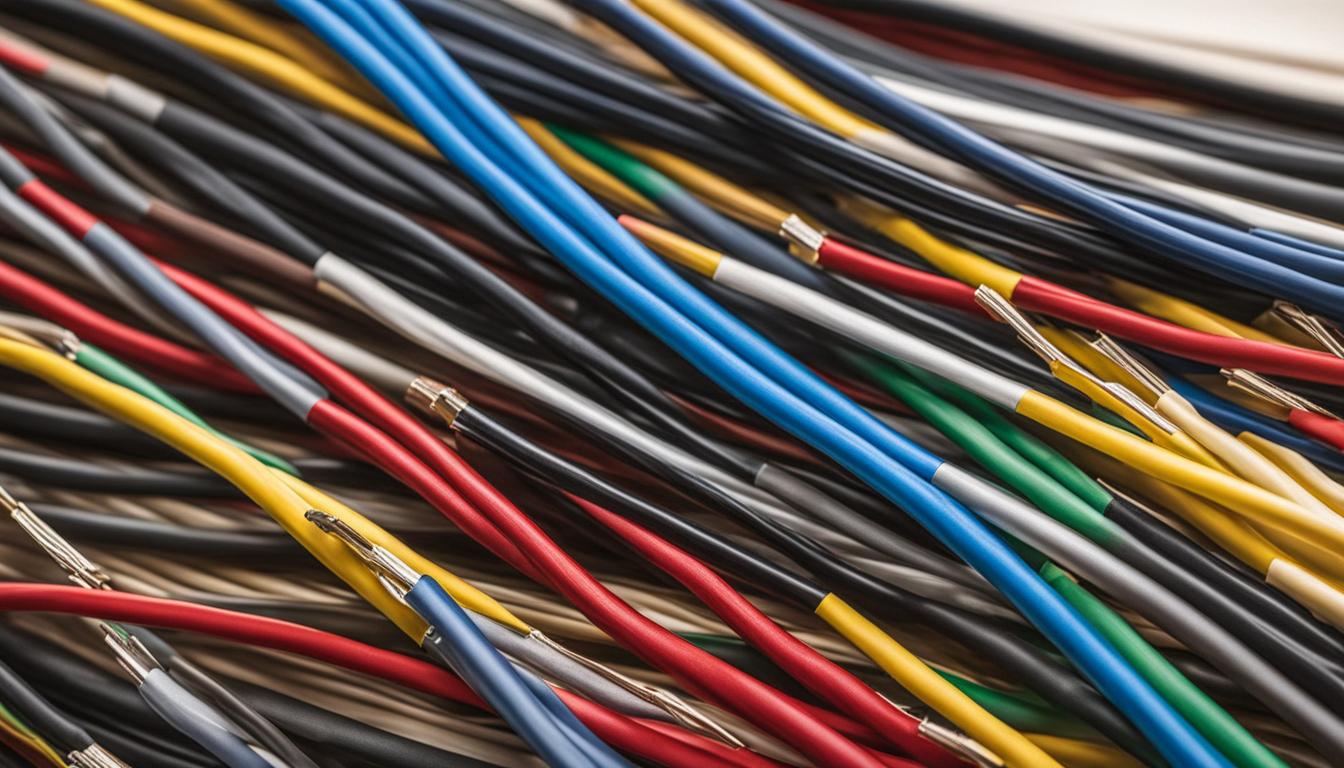
Choosing the Right Wire for Hot Tub Wiring
When it comes to wiring a hot tub, choosing the right wire is crucial for a safe and efficient installation. There are several factors to consider, including the type of wire and the appropriate wire size for your hot tub. Let’s explore the options to help you make an informed decision.
Benefits of Copper Stranded Wire
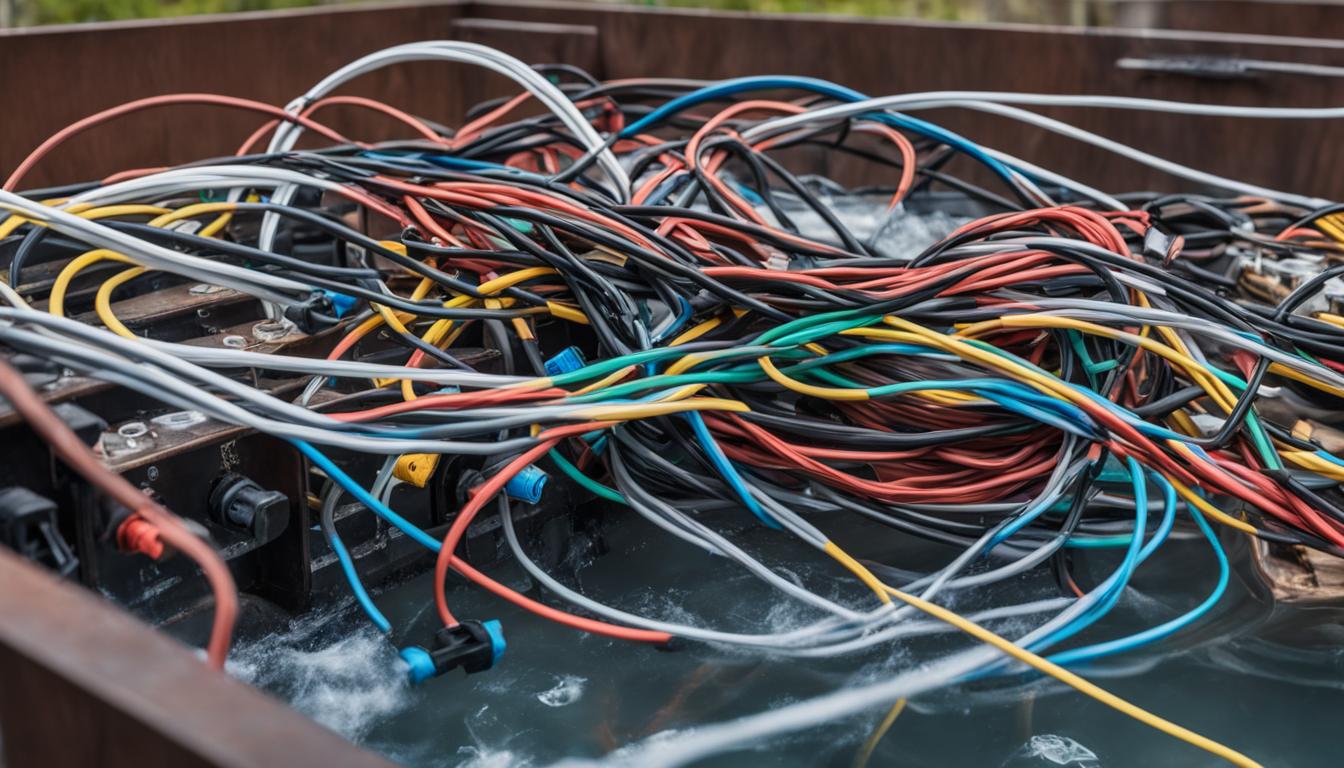
For hot tub wiring, copper-stranded wire is highly recommended. Copper is a durable and reliable material that can withstand the demands of hot tub usage. Unlike aluminum wire, which can corrode in hot tub water, copper is resistant to corrosion, ensuring a long-lasting connection.
Stranded wire, as opposed to solid wire, is the preferred choice for hot tub wiring. Stranded wires are easier to work with and provide better flexibility, making installation smoother and minimizing the risk of wire damage.
The Popular Choice: THHN/THWN Wire
One of the most popular choices for hot tub wiring is THHN/THWN wire. This type of wire is commonly used in residential applications, including hot tub installations. THHN/THWN wire is placed in a conduit, which provides insulation and protects it from external elements.
Steel Wire Armored (SWA) Cables
Another option to consider for hot tub wiring is steel wire armored (SWA) cables. SWA cables are made of copper conductors encased in a protective steel armor. These cables do not require a conduit, which can simplify the installation process. SWA cables are a reliable choice for outdoor applications, including hot tubs.
Choosing the Correct Wire Size
The wire size plays a vital role in ensuring the efficient operation of your hot tub. Using the right wire size will prevent issues such as overheating and circuit overload. The correct wire size depends on factors such as the circuit, length of the run, and manufacturer’s specifications.
A common range of wire sizes for hot tubs is 6 AWG to 12 AWG. However, it is essential to consult the manufacturer’s instructions and wiring diagrams specific to your hot tub model to determine the appropriate wire size. Investing in the correct wire size will guarantee a safe and reliable electrical connection for your hot tub.
| Wire Gauge | Maximum Ampacity |
|---|---|
| 6 AWG | 65 Amps |
| 8 AWG | 50 Amps |
| 10 AWG | 30 Amps |
| 12 AWG | 20 Amps |
Table: Wire Sizes and Maximum Ampacity for Hot Tub Wiring
Consulting a licensed electrician is highly recommended when determining the proper wire size for your hot tub, ensuring compliance with electrical safety standards.
“Choosing the right wire for hot tub wiring is essential for a safe and efficient installation. Copper stranded wire and THHN/THWN wire are popular options that provide durability and insulation. Steel wire armored cables (SWA) offer convenience, eliminating the need for conduit. Remember to use the correct wire size based on the circuit requirements and consult a professional for expert guidance.”
Now that you understand the importance of selecting the right wire for hot tub wiring, you can proceed with confidence, knowing that you are making a well-informed choice for a safe and reliable hot tub installation.
Understanding Wiring Codes and Regulations for Hot Tubs
When it comes to wiring your hot tub, it’s important to understand and comply with the applicable wiring codes and regulations. The National Electric Code (NEC) sets the standards for electrical installations, including those for hot tubs. By following these codes, you can ensure the safety and proper operation of your hot tub.
According to the NEC, hot tubs require GFCI (Ground Fault Circuit Interrupter) protected circuits to provide ground fault protection. This is essential for preventing electrical shocks and protecting your hot tub users from potential harm. GFCI protection should be integrated into the hot tub circuit wiring to meet safety requirements.
In addition, the NEC specifies that the wiring for hot tubs should be placed in rigid metal conduit, intermediate metal conduit, or PVC conduit for underground installations. This ensures that the wiring is protected from physical damage and moisture, maintaining the integrity of the electrical connection.
Adhering to local code regulations is also crucial for hot tub wiring. These regulations may vary depending on your location, so it’s essential to consult with a licensed electrician who is familiar with the specific requirements in your area. They can guide you through the permitting process and ensure that your hot tub wiring meets all local code requirements.
Obtaining necessary permits and inspections is an important step in hot tub wiring. This helps to ensure that the electrical installation is carried out correctly and in compliance with all relevant regulations. The inspections provide assurance that your hot tub is wired safely and operates efficiently.
By understanding and adhering to the wiring codes and regulations, you can confidently wire your hot tub and enjoy a safe and relaxing experience for years to come.
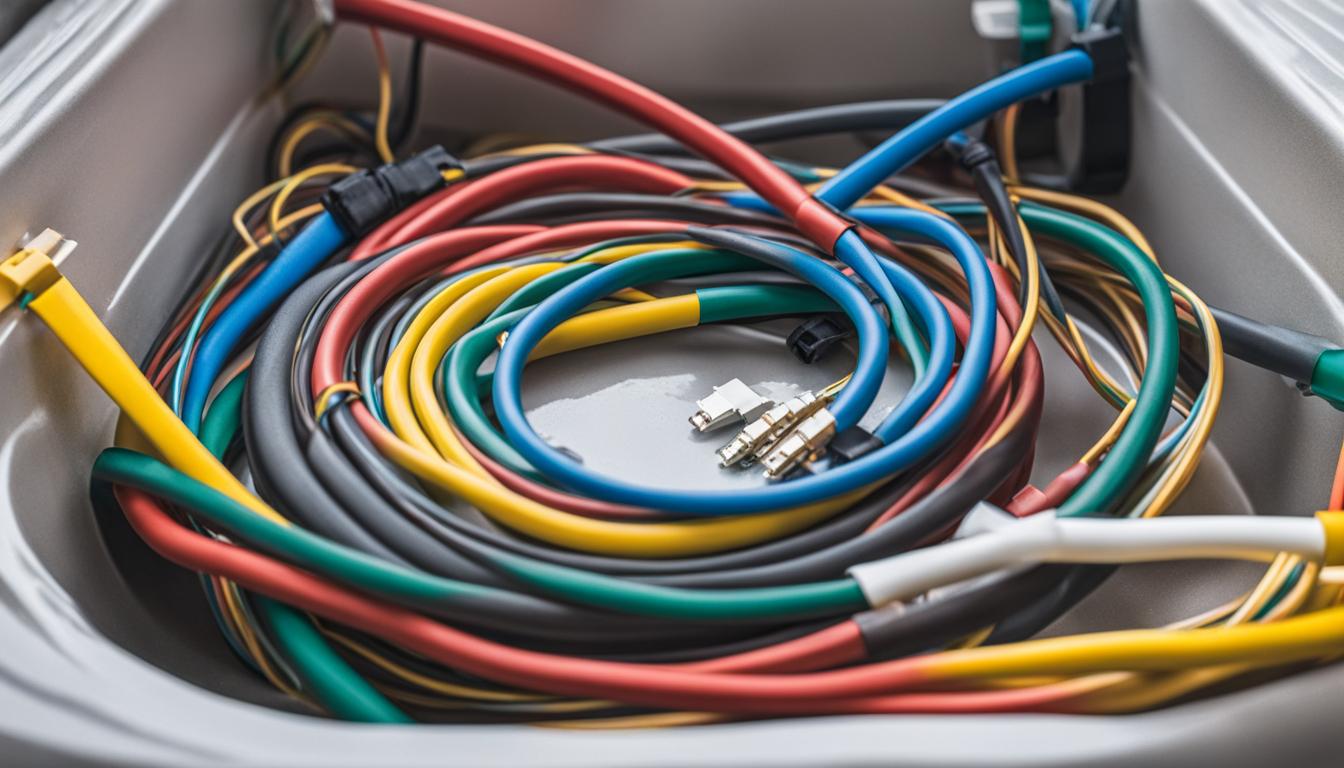
Key Takeaways:
- Hot tubs require GFCI-protected circuits for ground fault protection.
- Wiring should be placed in rigid metal conduit, intermediate metal conduit, or PVC conduit for underground installations.
- Adhere to local code regulations and obtain necessary permits and inspections for hot tub wiring.
Types of Wires to Avoid for Hot Tub Wiring
When it comes to wiring a hot tub, it’s crucial to use the right wires that meet the necessary safety requirements. However, certain types of wires should be avoided for hot tub installations. These wires include UF-B wire and Romex (NM-B). Let’s take a closer look at why these wires are not suitable for hot tub wiring and what alternatives you should consider.
Why avoid UF-B wire?
UF-B wire, also known as underground feeder cable, is commonly used for outdoor applications. However, it is not recommended for hot tub wiring. UF-B wire is prohibited for use in outdoor water constructions, including hot tubs. Using UF-B wire for hot tub installations can pose significant safety risks and may result in electrical malfunctions or accidents.
Why avoid Romex (NM-B)?
Romex, or non-metallic sheathed cable (NM-B), is a commonly used electrical cable for indoor applications. However, it is not suitable for hot tub wiring. Romex is strictly an indoor cable and is not permitted for outdoor conduit. Using Romex for hot tub installations can compromise the electrical integrity and safety of the wiring system.
It is crucial to use wires that are approved for outdoor and underground applications when wiring a hot tub. These wires are specifically designed to withstand environmental conditions and provide reliable and safe electrical connections. Here are some alternatives to consider for hot tub wiring:
- Copper-stranded wire: Choose copper-stranded wire for hot tub installations, as it is durable and corrosion-resistant.
- THHN/THWN wire: THHN/THWN wire is commonly used for hot tub wiring as it provides the necessary insulation and protection. This wire is typically placed in a conduit.
- Steel wire armored cables (SWA): SWA cables are another option for hot tub wiring as they do not require conduit. These cables provide the necessary strength and protection for outdoor installations.
By using the right wires for your hot tub installation, you can ensure a safe and reliable electrical connection. Always consult with a licensed electrician and follow the manufacturer’s specifications and NEC guidelines to ensure proper wiring and compliance with local codes.
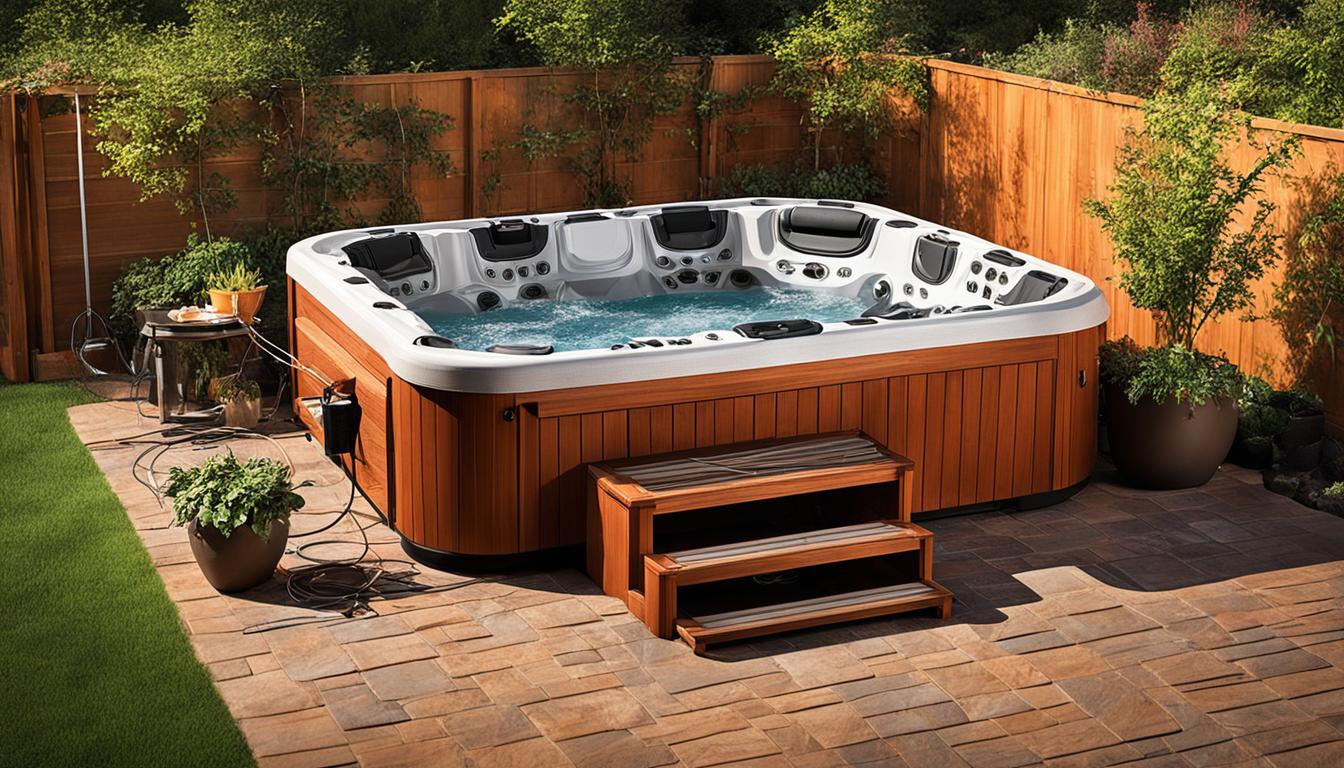
The Importance of Wire Sizing for Hot Tub Wiring
When it comes to wiring a hot tub, choosing the right wire size is of utmost importance. The size of the wires for hot tub wiring depends on various factors such as the circuit, length of the run, and manufacturer’s specifications. Using the correct wire size ensures proper electrical flow and prevents issues like overheating or circuit overload.
Hot tub wire gauge typically ranges from 6 AWG to 12 AWG, with lower numbers indicating thicker wires. The specific wire size required for your hot tub will depend on its electrical requirements and the distance from the main electrical panel.
To determine the appropriate wire size for your specific hot tub model, it’s advisable to consult the hot tub wiring diagram provided by the manufacturer. This diagram outlines the electrical specifications and can guide you in selecting the correct wire gauge for your installation.
Choosing the correct wire size is crucial for maintaining a safe and efficient electrical connection for your hot tub. If the wire size is too small, it can lead to overheating, which can be a safety hazard. On the other hand, using a wire that is too large for the circuit can be unnecessary and costly.
By ensuring the proper wire sizing for your hot tub wiring, you can have peace of mind knowing that your hot tub will operate safely and efficiently.
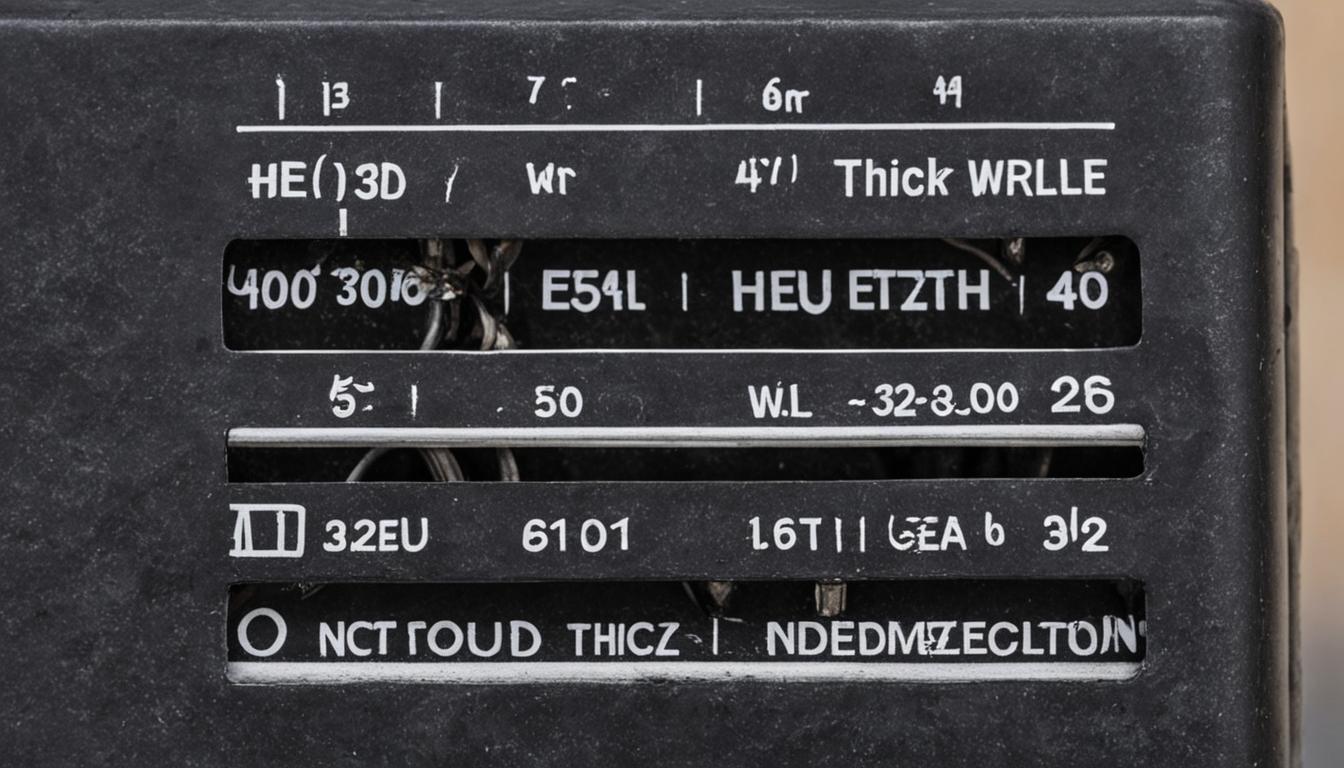
Note: The image above showcases the importance of selecting the right wire gauge for hot tub wiring.
Wiring a 50-amp Hot Tub
When it comes to wiring a 50-amp hot tub, it’s important to ensure that the electrical connection is done correctly to guarantee a safe and efficient operation. The 50-amp hot tub requires either 6 or 8-gauge wires, depending on the specific manufacturer’s specifications. These wires are designed to handle the higher current draw of a 50-amp circuit compared to lower amperage options.
It is crucial to have a dedicated GFCI (Ground Fault Circuit Interrupter) breaker with a 240-volt connection for the hot tub. The GFCI breaker provides protection against electrical shock and helps prevent damage to the hot tub or any connected equipment. The 240-volt connection ensures that the hot tub receives the necessary power supply for optimal performance.
During the installation process, the wiring should be properly connected to the hot tub control box. The control box is responsible for receiving and distributing power to various components of the hot tub, such as the pumps, heaters, and lights. It is important to follow the manufacturer’s guidelines and wiring diagrams to ensure the correct connection and prevent any potential damage to the hot tub.
Adhering to the NEC (National Electric Code) guidelines for outdoor spas is essential. The NEC provides standards and regulations for electrical installations to maintain safety and prevent hazards. By following these guidelines, you can ensure that your hot tub wiring meets the necessary requirements and operates safely.
Here is a table summarizing the key details for wiring a 50-amp hot tub:
| Requirement | Description |
|---|---|
| Wire Gauge | 6 or 8-gauge |
| GFCI Breaker | Required |
| Voltage | 240 volts |
| Connection | Proper connection to the hot tub control box |
| Compliance | Adherence to NEC guidelines for outdoor spas |
By following these steps and ensuring that the proper wiring is in place, you can enjoy your 50-amp hot tub safely and confidently.

Wiring a 60-amp Hot Tub
When it comes to wiring a 60-amp hot tub, it’s important to follow the proper guidelines to ensure a safe and efficient electrical connection. To provide adequate electrical flow, you’ll need to use 6 gauge wires for your hot tub installation. These wires are designed to handle the higher amperage and ensure reliable performance.
In addition to the appropriate wire size, it’s crucial to install a dedicated GFCI (Ground Fault Circuit Interrupter) breaker for your hot tub. This breaker should be rated at 60 amps and connected to a 240-volt power supply. The GFCI breaker will provide protection against electrical faults and help ensure the safety of your hot tub.
When wiring your 60-amp hot tub, always refer to the manufacturer’s specifications and wiring diagrams. These documents will provide you with the necessary instructions and information specific to your hot tub model. Following the manufacturer’s guidelines will ensure the correct wire size, proper installation, and compliance with any warranty requirements.
Tip: Consult with a licensed electrician who has experience in hot tub installations. They can offer valuable expertise and ensure that your wiring meets all safety and code requirements.
Properly wiring a 60-amp hot tub is essential for the safe and reliable operation of your spa. By using the correct wire size, installing a dedicated GFCI breaker, and following the manufacturer’s instructions, you can enjoy your hot tub with peace of mind, knowing that it is wired correctly and adheres to all electrical safety standards.
Wiring a 30-amp Hot Tub
When it comes to wiring a 30-amp hot tub, there are a few key considerations to keep in mind. The electrical requirements for a 30-amp hot tub include using either 10 or 12-gauge wires, depending on the specific manufacturer’s specifications.
It is essential to consult the wiring diagrams provided by the hot tub manufacturer to ensure accurate and precise wiring. By adhering to the specific guidelines, you can ensure the correct wire gauge is selected, and a safe electrical connection is established.
In addition to selecting the appropriate wire size, a dedicated GFCI (Ground Fault Circuit Interrupter) breaker with a 240-volt connection should be installed for the hot tub. This breaker is designed to provide the necessary protection against ground faults and electrical hazards.
Adhering to the National Electric Code (NEC) guidelines is paramount when wiring a 30-amp hot tub. The NEC provides comprehensive regulations and safety standards for electrical installations, ensuring the highest level of safety and compliance.
Benefits of Hiring a Licensed Electrician
Wiring a 30-amp hot tub can be a complex task that requires knowledge and expertise. Hiring a licensed electrician can offer several benefits, including:
- Professional Expertise: A licensed electrician will have the necessary knowledge and experience to properly wire the 30-amp hot tub.
- Compliance with Regulations: An electrician will ensure that the wiring meets all relevant electrical codes and regulations.
- Safety Assurance: With a licensed electrician, you can have peace of mind knowing that the hot tub is wired safely and securely.
- Troubleshooting Assistance: In the event of any issues or electrical problems, a licensed electrician will be able to troubleshoot and resolve them effectively.
By hiring a licensed electrician, you can ensure that your 30-amp hot tub is wired correctly, providing you with a safe and enjoyable hot tub experience.
| Wire Gauge | Diameter (in inches) | Diameter (in millimeters) | Maximum Ampacity |
|---|---|---|---|
| 10 AWG | 0.1019 | 2.5883 | 30 Amps |
| 12 AWG | 0.0808 | 2.05312 | 20 Amps |
Table: Wire Gauge and Maximum Ampacity for 30-Amp Hot Tub Wiring
Consult the table above to determine the appropriate wire gauge for your 30-amp hot tub wiring needs. The wire gauge directly affects the maximum ampacity, ensuring optimal electrical performance and safety.
Remember, wiring a 30-amp hot tub should always be done by a licensed electrician to ensure compliance with regulations and to safeguard against potential hazards.
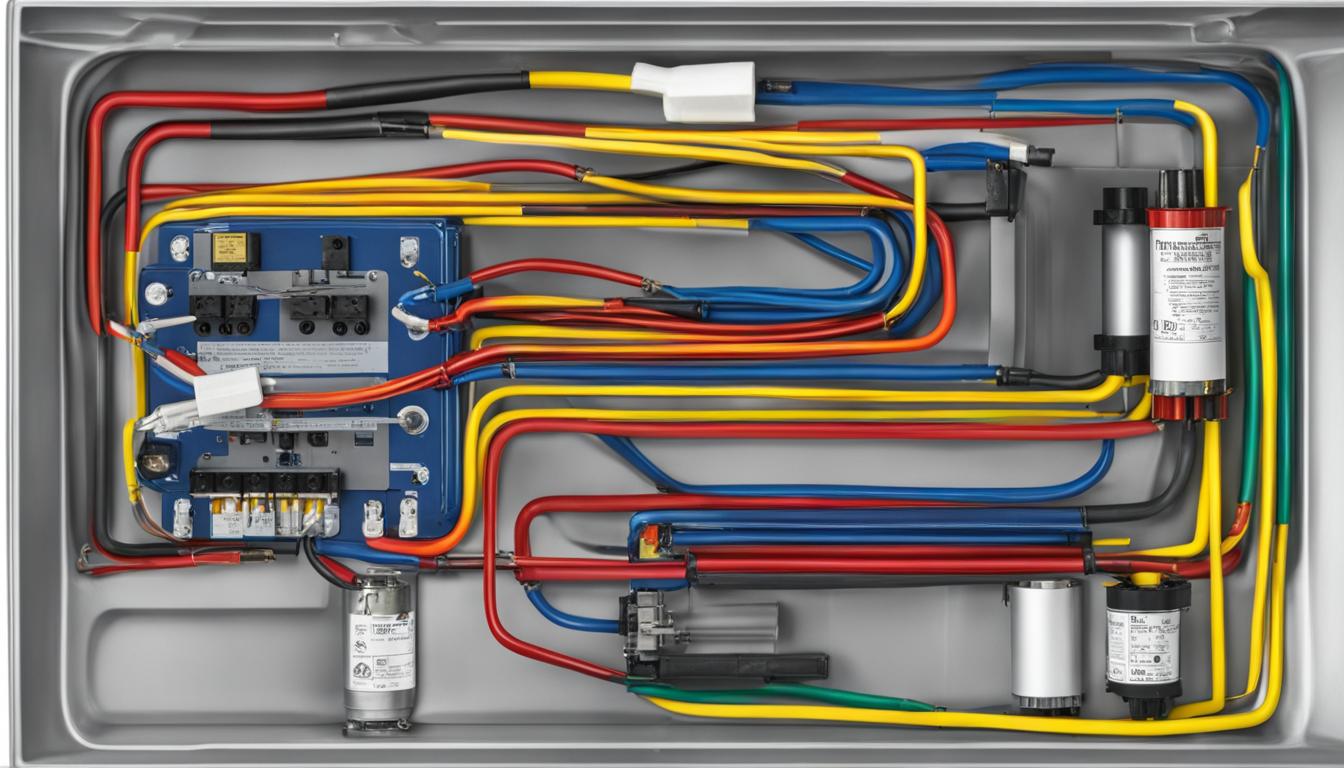
Wiring a 40-amp Hot Tub
When it comes to wiring a 40-amp hot tub, it is important to use the correct wire size to ensure the safety and efficiency of your spa. Depending on the specific manufacturer’s specifications, you will need either 10 or 8-gauge wires for the installation. This will allow for the proper electrical flow and prevent any issues that may arise from using inadequate wiring.
It is crucial to follow the manufacturer’s instructions carefully when wiring your hot tub. The instructions will provide you with the specific requirements and guidelines for your model. Make sure to adhere to these instructions to ensure a successful and safe installation.
Additionally, a dedicated GFCI breaker with a 240-volt connection is necessary for a 40-amp hot tub. This breaker will provide the necessary protection for your electrical circuit. Be sure to consult with a licensed electrician to ensure proper installation and compliance with code regulations.
By using the correct wire size and following the manufacturer’s instructions, you can confidently wire your 40-amp hot tub and enjoy a relaxing soak without any electrical concerns.
| Wire Gauge | Manufacturer Recommendation |
|---|---|
| 10 AWG | Depending on the manufacturer’s specifications |
| 8 AWG | Depending on the manufacturer’s specifications |
Conclusion
Proper wiring is crucial for the safe and efficient operation of a hot tub. When it comes to hot tub wiring, it is essential to hire a licensed electrician who can ensure that the electrical connection meets all necessary requirements. By following the manufacturer’s specifications and adhering to the National Electric Code (NEC) guidelines, you can ensure a reliable and safe electrical connection for your hot tub.
Choosing the right wire is also important in hot tub wiring. The copper-stranded wire is highly recommended, as it is resistant to corrosion that may occur in hot tub water. THHN/THWN wire is a popular choice, providing insulation and protection when placed in a conduit. Consulting hot tub wiring diagrams and obtaining professional advice can help determine the appropriate wire size for your specific hot tub model and circuit.
Adherence to local code regulations is crucial in hot tub wiring. Obtaining the necessary permits and inspections will ensure that your hot tub wiring meets all safety standards. Remember, when it comes to hot tub wiring, consulting professionals and seeking help when in doubt is always the best approach to ensure the safety and reliability of your hot tub’s electrical connection.
FAQ
What are the different types of wires for hot tubs?
The copper-stranded wire is recommended for hot tub wiring. The most popular choice is the THHN/THWN wire, which is placed in a conduit. Steel wire armored cables (SWA) are also a common option.
Why is hiring a licensed electrician important for hot tub wiring?
Hiring a licensed electrician ensures that the hot tub is wired correctly and meets safety standards. They understand the electrical requirements and can navigate local code regulations.
What are the electrical requirements for different types of hot tubs?
Traditional backyard hot tubs require a dedicated GFCI breaker with a 240-volt/50-amp connection. Plug-and-play hot tubs can be plugged into a standard outlet but should have their own circuit.
What type of wire should I choose for hot tub wiring?
Copper-stranded wire, such as THHN/THWN wire, is recommended for hot tub wiring. It should be the correct gauge size for the circuit and the length of the run.
What are the wiring codes and regulations for hot tubs?
Hot tub wiring is regulated by the National Electric Code (NEC) and specific requirements for outdoor installations. GFCI-protected circuits and proper conduit are among the regulations.
What types of wires should I avoid for hot tub wiring?
UF-B wire and Romex (NM-B) should not be used for hot tub wiring as they are not suitable for outdoor and underground installations.
Why is wire sizing important for hot tub wiring?
Using the correct wire size ensures proper electrical flow, prevents issues like overheating or circuit overload, and complies with the manufacturer’s specifications.
How do I wire a 50-amp hot tub?
A 50-amp hot tub requires either 6 or 8-gauge wires, a dedicated GFCI breaker, and a 240-volt connection. Consult the manufacturer’s specifications and wiring diagrams for proper installation.
How do I wire a 60-amp hot tub?
A 60-amp hot tub requires 6 gauge wires for proper electrical flow. It should have a dedicated GFCI breaker and a 240-volt connection. Reference the manufacturer’s specifications and wiring diagrams.
How do I wire a 30-amp hot tub?
A 30-amp hot tub requires either 10 or 12-gauge wires, a dedicated GFCI breaker, and a 240-volt connection. Consult the manufacturer’s specifications and wiring diagrams for proper installation.
How do I wire a 40-amp hot tub?
A 40-amp hot tub requires either 10 or 8-gauge wires, a dedicated GFCI breaker, and a 240-volt connection. Reference the manufacturer’s specifications and wiring diagrams for proper installation.

